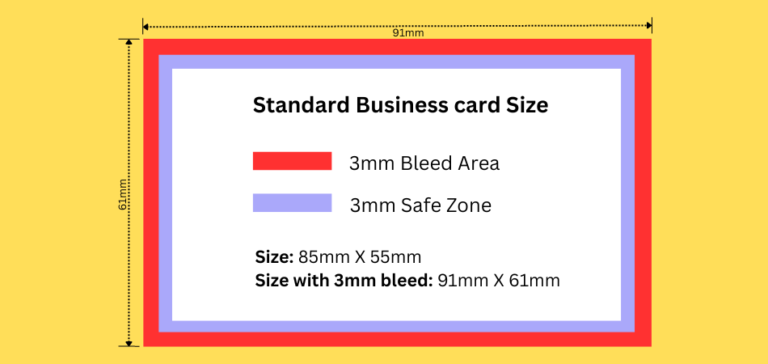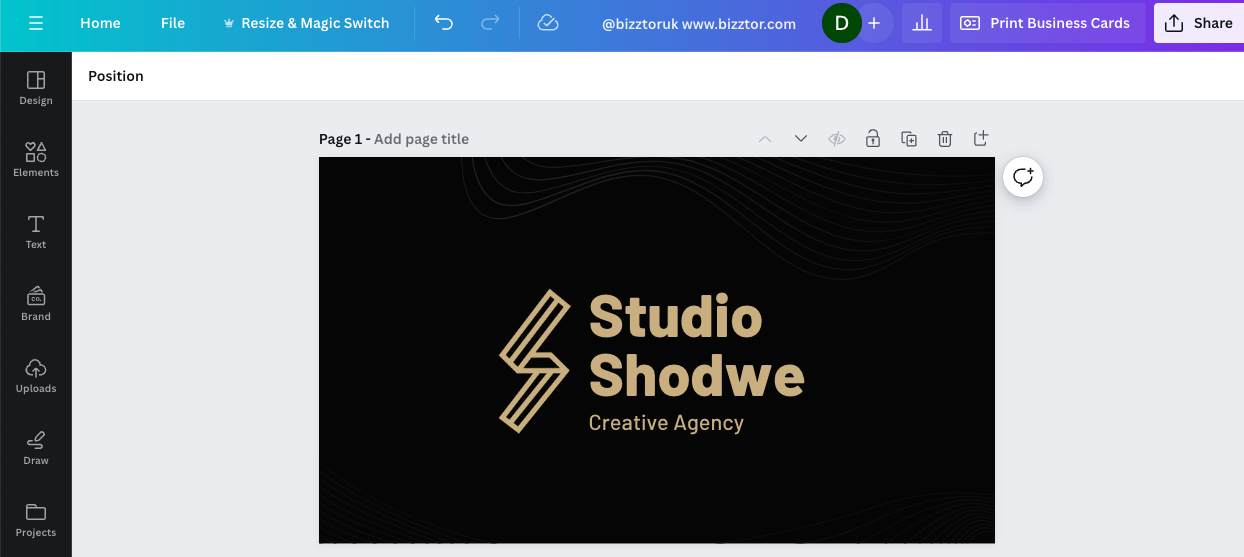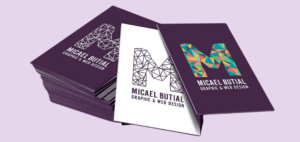
Business Card Size UK – Standard Dimensions & Size Guide

- Published / Last Edited on:
Standard Business Card Size UK
The standard business card size in the UK is 85mm x 55mm (8.5cm X 5.5cm). It is most common size used in the UK, Ireland and other EU countries, Being the standard business card size, it is cost effective to print than other sizes in the UK.
Download Standard Business Cards pdf Template
Business cards dimensions in cm
The standard size of business card in centimeters is 8.5cm X 5.5cm.
Business cards size in pixels
The standard business cards size in the UK in pixels is 1004px x 650px ( at 300 DPI )
Standard UK business card size:
| Measurement | Width | Height |
|---|---|---|
| Millimeters | 85 mm | 55 mm |
| Centimeters | 8.5 cm | 5.5 cm |
| Inches | 3.35 inch | 2.17 inch |
| Pixels (300 PPI) | 1004 px | 650 px |
Note on Pixel Conversion:
Pixel dimensions are based on a resolution of 300 PPI, which is standard for high-quality prints. If a different resolution is used, the pixel values would change accordingly.
The pixel values are rounded to the nearest whole number.
Print Bleed on business cards
A 3mm bleed is typically needed on business cards, so the size with 3mm bleed will be 91mm x 61mm, the extra 3mm from all sides will be trimmed after printing.
Any background colour/image needs to be extended to this size so that the finished product does not have any thin white line around. Need more Info on print bleed, then read our post on What is bleed in printing.
Other Business Cards Sizes in the UK
85mm X 55mm being the most used size in the uk, people still use some other size business cards, Like Square business cards (55mm X 55mm) and mini Business cards (85mm x 25mm) or Folded Business cards.

Why Standard Size Business Cards are Popular
Convenience:
- Pocket-friendly: This size fits comfortably in wallets, pockets, and business card holders without bulging or bending. It’s easy to carry and readily accessible when needed.
- Standardised for printing: Most printers and online printing services offer this size readily, making it convenient and affordable to order.
- Easy to design: The dimensions provide a comfortable layout for essential information like name, contact details, and logo without feeling cramped or cluttered.
Compatibility:
- Universal acceptance: This size is recognised and commonly used in the UK and many other European countries, ensuring its acceptability across diverse audiences.
- Fits standard holders: It seamlessly slides into business card holders at networking events, trade shows, and conferences, preventing them from getting lost or misplaced.
- Familiarity breeds trust: The familiar size subconsciously conveys professionalism and adherence to industry standards, potentially enhancing the recipient’s perception of your brand.
Additional benefits:
- Cost-effective: The smaller size often translates to lower printing costs compared to larger cards, offering an advantage for budget-conscious businesses.
- Environmentally friendly: Using less material reduces resource consumption and environmental impact, appealing to eco-conscious individuals and businesses.
- Versatility: Despite its compact size, it offers enough space for essential information and basic design elements, making it suitable for a wide range of industries and professions.

Considerations When Choosing a Business Card Size:
1. Brand Identity:
- Standard size (85mm x 55mm): This size conveys professionalism and is compatible with wallets and holders. Ideal for established brands or those targeting a traditional audience.
- Square sizes (e.g., square, 55mm x 55mm): Make a statement and stand out from the crowd with unique style. Suitable for creative, modern, or luxury brands aiming for a premium feel.
- Smaller sizes (e.g., mini, 25mm x 85mm): Convey minimalism, exclusivity, or eco-consciousness. Works well for personal brands, artists, or businesses focusing on portability.
2. Target Audience:
- Business professionals: Expect a standard size for easy storage and reference.
- Younger demographics: May be more receptive to unique shapes or larger sizes.
- International audience: Consider regional preferences. Standard sizes dominate in UK, Ireland and Europe, while Square cards are popular in Asia.
3. Design Complexity:
- Standard size: Suitable for basic information and simple visuals.
- Smaller sizes: Focus on clarity and key information due to limited space. Use bolder fonts and minimal graphics.
4. Printing and Finishing:
- Standard size: Widely available and compatible with most printing techniques and finishes.
- Smaller sizes: Printing quality for small text or intricate details can be challenging. Choose appropriate fonts and consider digital printing.
Additional Considerations:
- Budget: Larger sizes and special finishes generally cost more.
- Portability: Ensure the size fits comfortably in wallets and pockets.
- Durability: Thicker cardstock or specific finishes can enhance longevity.
- Environmental impact: Opt for recycled materials or smaller sizes for an eco-friendly approach.
Also Read: The Essential Guide to Business Card Design in the UK
Designing a UK Business Card with Bleed in Canva:
Canva is a user-friendly online design platform perfect for creating business cards even without graphic design experience. Here’s how to design a UK card with bleed:

1. Choose a Template or Start From Scratch:
- Open Canva and search for “Business Cards”.
- Select a pre-designed template with bleed (look for templates mentioning “bleed” or “3mm bleed”).
- Alternatively, choose “Custom Dimensions” and set the size to 91mm x 61mm (including bleed).
2. Design Your Card:
- Drag and drop design elements like text, logos, and images onto the canvas.
- Remember, important information and logos should stay within the 85mm x 55mm safe area, avoiding the 3mm bleed zone.
- Use Canva’s editing tools to customize fonts, colors, and graphics.
- Canva provides bleed guides as dotted lines to help you position elements accurately.
3. Pro Tip:
- Use Canva’s “Background Remover” tool to easily create transparent backgrounds for logos or images that should seamlessly extend to the edge.
4. Download and Print:
- When you’re happy with your design, click “Download”.
- Choose “PDF Print” for high-quality printing.
- Select “Standard Bleeds” to include the 3mm bleed automatically.
- Check your printing company’s specific PDF requirements and bleed preferences.
Additional Tips:
- Explore Canva’s premium elements for more design options and fonts.
- Use high-resolution images and logos for best results.
- Play with different colour palettes and layouts to find your brand’s perfect match.
- Share your design on social media or download it as a digital business card.
Remember: Canva offers intuitive tools and templates, making it easy to create professional-looking business cards with bleed, even for design beginners.
Also Read: How to create qr code for business card
Looking to create a business card using MS Word?
While professional graphic design software provides more flexibility, it’s possible to create a business card with bleed in Microsoft Word. This guide will help you on how to make business cards using word.
Hope this guide will help you with your business card design needs, if you need any other help, please email us on sales@nearprint.co.uk and we will be happy to assist.




